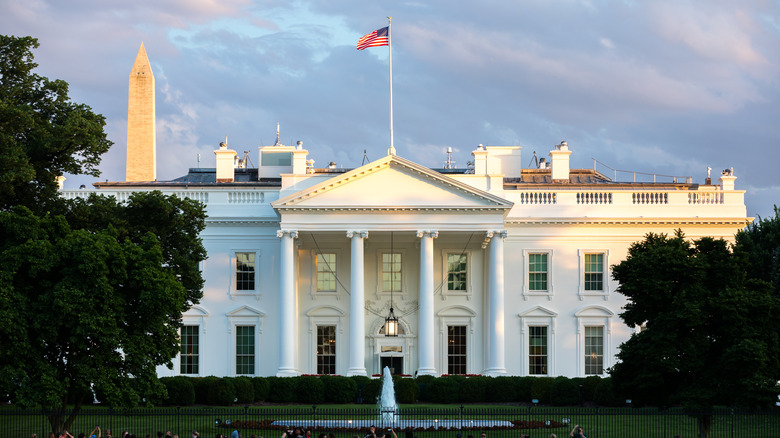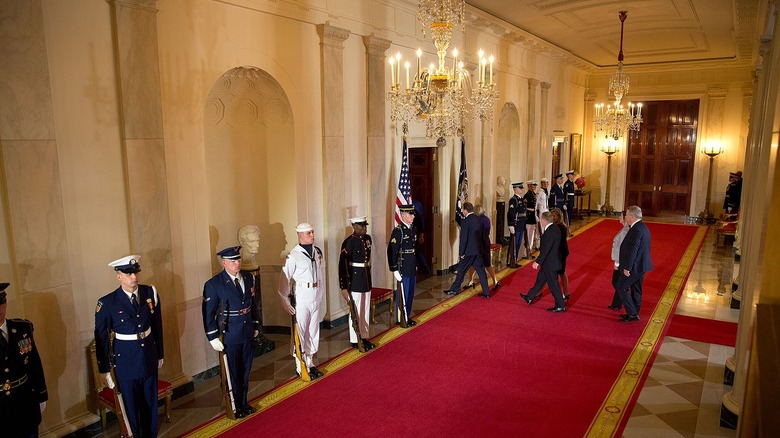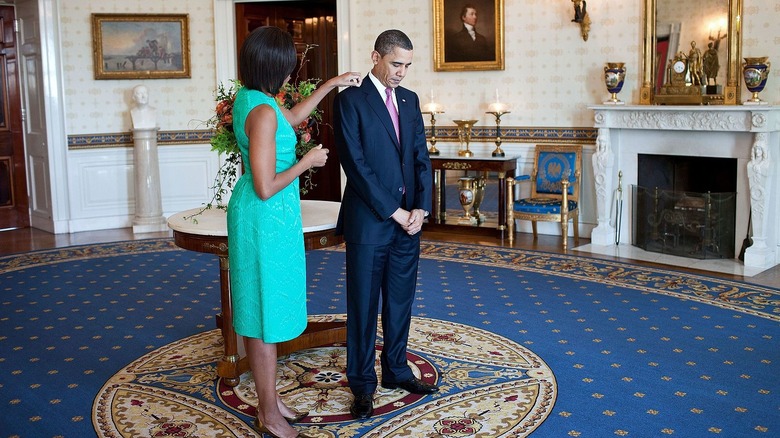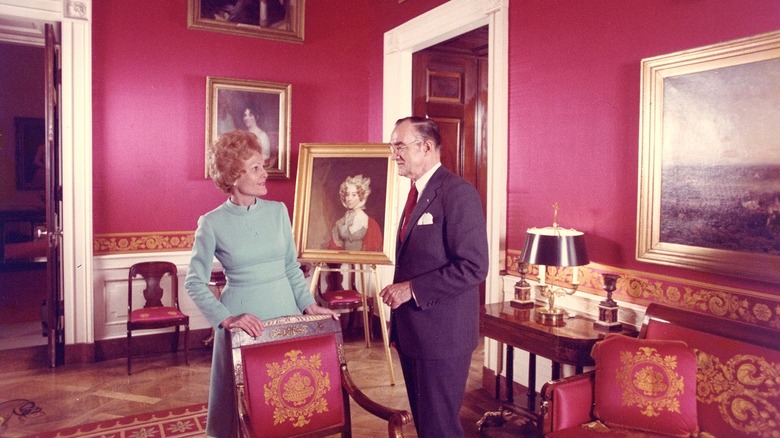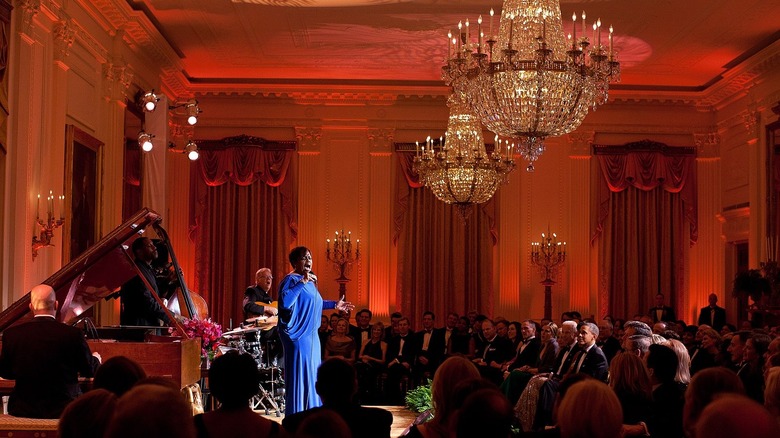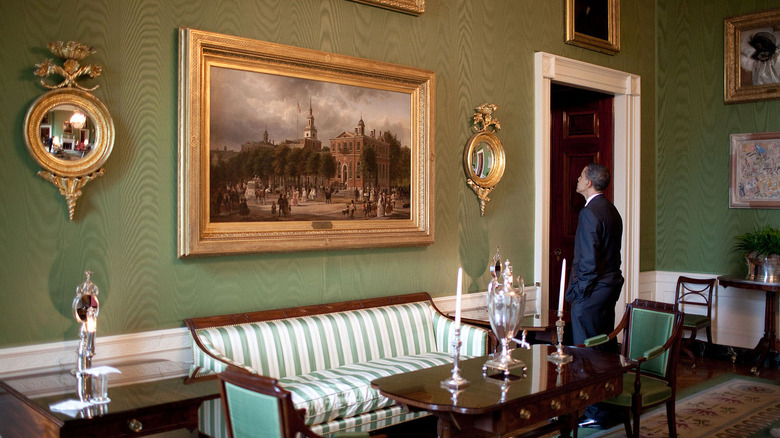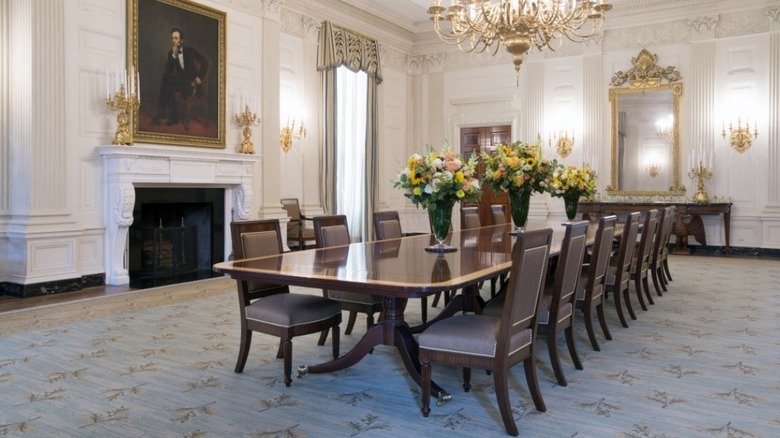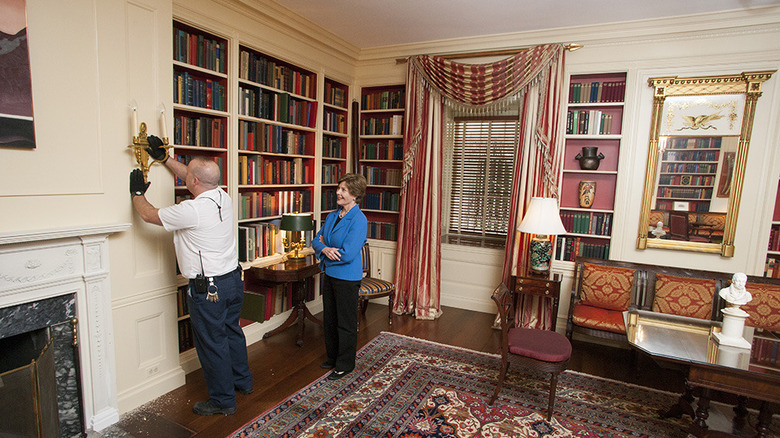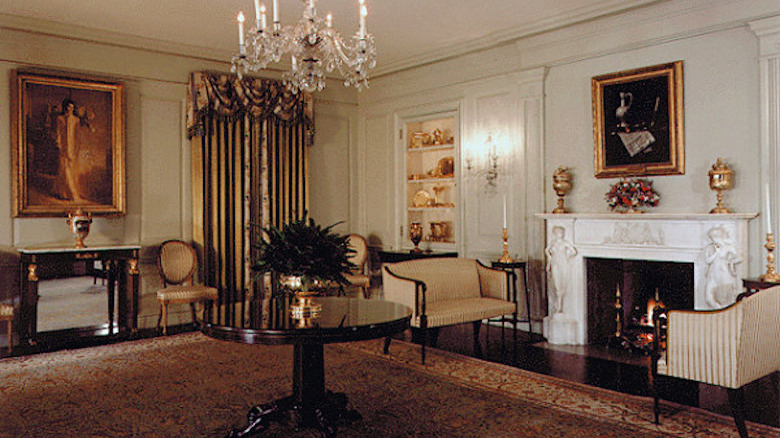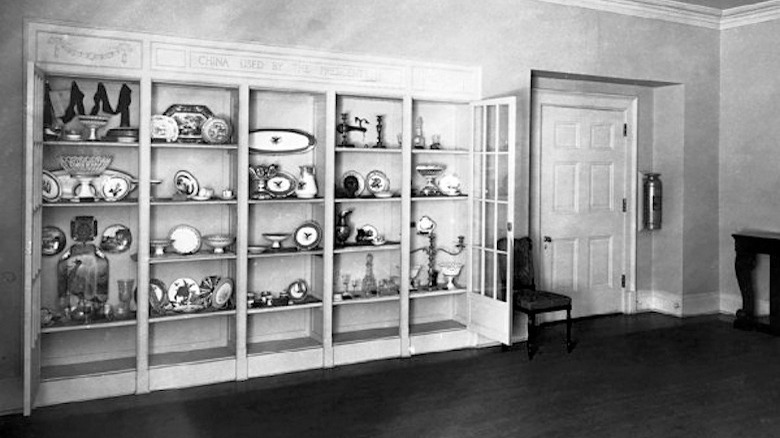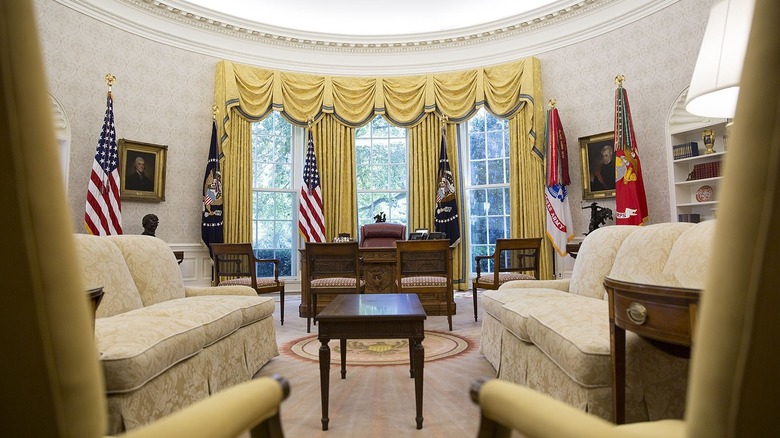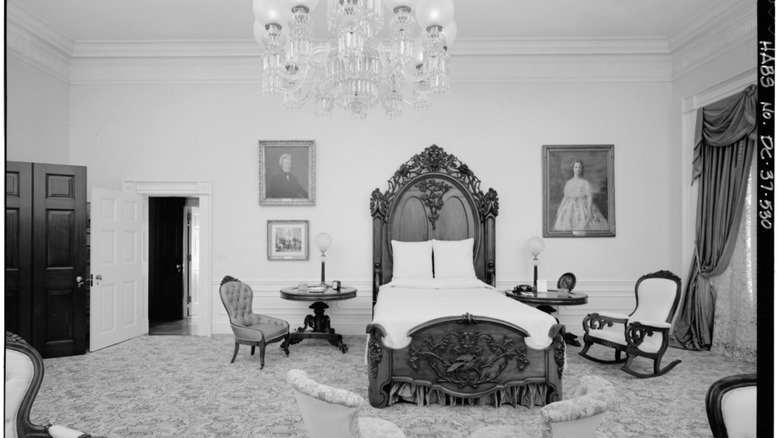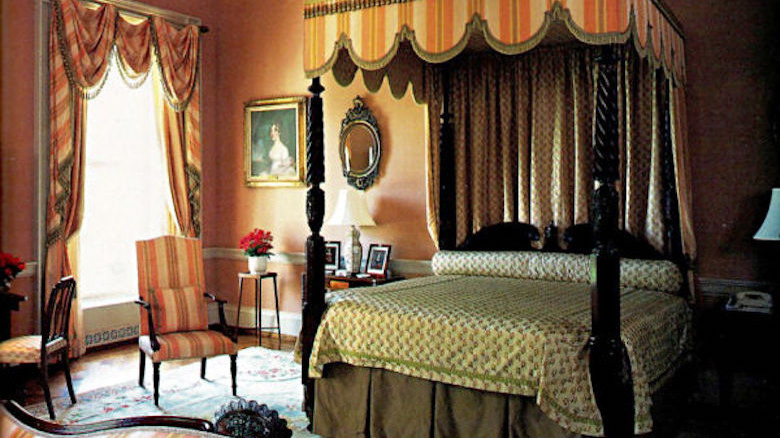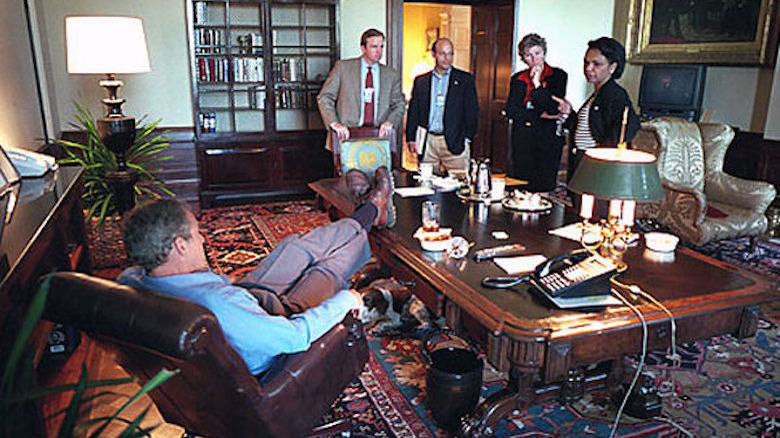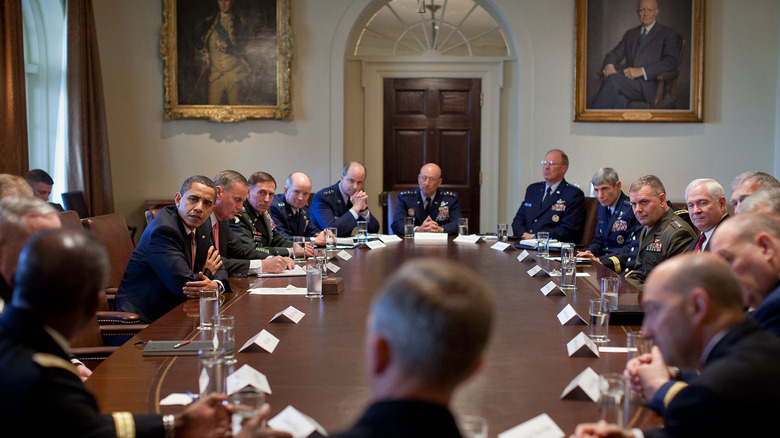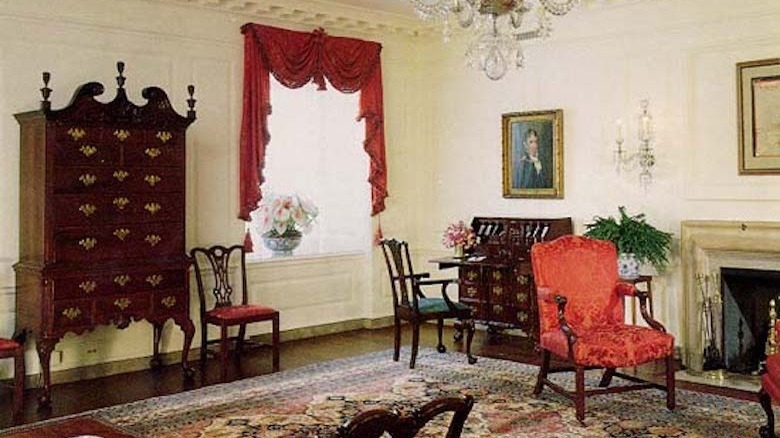The Real Meaning Behind These Famous Rooms Of The White House
According to History.com, each and every president of the United States has lived and worked in the White House at 1600 Pennsylvania Avenue since the year 1800. The structure is brimming with history dating back hundreds of years — and filled with 132 different rooms, each with their own story (per the White House Archives). From the iconic Oval Office to the exclusive White House Library, there is meaning behind every room's name, design, and (occasionally) the architecture itself.
So why are the Red, Blue, and Green Rooms in the White House themed with specific colors? Is the Map Room actually filled with maps? Why was the Oval Office built in an oval shape? We had more questions than answers about the history of this landmark American building, prompting us to go through some of the most famous rooms in the White House and uncover the secrets behind them. Keep reading to find out the stories of 16 historical rooms in the White House.
The Entrance Hall and Cross Hall
Both the Entrance Hall and Cross Hall were integral parts of the original White House design — created by architect James Hoban. According to The White House Historical Association, the Cross Hall was specifically created to connect to all of the state rooms on the north side of the White House, and then open into the Entrance Hall. Originally, this reception area featured two different staircases. But when the State Dining Room was extended in 1902, one staircase was torn out. The other remains as a grand staircase often used by presidents and first ladies. After all, it's important to make a memorable entrance when you're the leader of an entire country.
Other than the staircases, the most prominent renovations to both the Entrance Hall and Cross Hall were in the design. In 1882, a stained glass screen that stretched from the floor to the ceiling served as a divider between the two halls. It was created by Louis Tiffany (whose father founded Tiffany & Co., per The Charles Hosmer Morse Museum) for President Chester Arthur. It stayed like this until 1902, when the glass was taken out, and white plaster columns were put in its place.
The Blue Room
Despite its name, the Blue Room did not always take on a beautiful blue hue. James Hoban designed the room to be extremely elegant, with French doors and long windows — although a color scheme was not part of the original plans. Per The White House Historical Association, First Lady Dolley Madison was actually a fan of red velvet, and had both draperies and furniture in this particular fabric put in the room prior to 1814. After a fire ruined the furniture and decor, however, a major restoration and renovation took place.
Surprisingly, even though the room was completely redone post-fire, it didn't become a traditionally "blue" room until 1837. In 1817, President James Monroe brought in beechwood furniture which featured red upholstery. Later, John Adams decorated the room in red, and then Andrew Jackson changed the color scheme to green. Finally, Martin Van Buren began the tradition of outfitting the room in blue. And, according to the White House Archives, it continues to be used as a reception room today.
The Red Room
Since 1845, the Red Room has been a parlor filled with crimson furniture. Before this, though, the room was actually used as a meeting room for President Thomas Jefferson. Jefferson's office at the time was located where the State Dining Room is today — so the Red Room was in close proximity and ideal for meetings. It has become a parlor that first ladies often consider to be their favorite. They have used it throughout history as a "private parlor" to host friends and other guests.
In terms of decor details, a video tour of the Red Room gives us a glimpse into the space. The walls are painted a bright, bold red — covered with gold frames featuring historical portraits and other artwork. Illuminated by a stunning gold chandelier is the furniture, which remains crimson red to this day. Outfitted with various lamps, plants, and a striking marble fireplace, it's no wonder why this room has always been beloved.
The East Room
Though the East Room is used to house bill-signings, musical performances, and press conferences today, it was originally created to be a "Public Audience Room" by George Washington and James Hoban. And, according to The White House Historical Association, the room has had multiple other uses as well — including several years where it sat unfinished and undecorated. As a matter of fact, because John and Abigail Adams were the first presidential pair to actually reside in the Executive Mansion, there were several rooms still under construction at that time. But that doesn't mean they didn't make use of these spaces. During the Adams presidency, the East Room actually served as a place to dry laundry.
Of course, the room wasn't used to dry clothes forever. Throughout the White House's history, the East Room has held encamped soldiers and it is the place in which the Civil Rights Act came to be, according to The White House Historical Association. Nancy Reagan danced in the room with Frank Sinatra, while countless others have mourned the deaths of seven different presidents (including John F. Kennedy) in the same space (via Today). Out of all the rooms in the White House, the East Room holds some of history's most famous memories.
The Green Room
Adorned with green walls, green rugs, and plenty of green accents, the Green Room in the White House has been used for different celebrations and gatherings through the years. Per the White House Archives, first ladies Frances Cleveland and Eleanor Roosevelt hosted different events in this green parlor. Cleveland hosted her very first White House reception, and Roosevelt would invite guests inside the room prior to enjoying concerts in the East Room (which conveniently connects to the Green Room). But this room was not just used for joyous occasions. In 1862, the son of Abraham and Mary Todd Lincoln contracted typhoid fever, and his open casket was placed in the Green Room. After that, Mrs. Lincoln refused to step foot in the room (via the White House Archives).
Before it was officially labeled a parlor, though, this room served as a dining room for Thomas Jefferson. It featured a green canvas floor — a theme which clearly stuck. Then, in 1825, John Quincy Adams named the space the "Green Drawing Room" due to the color featured throughout. Even today, we can see in video tours that the room remains decked out in green — from the wallpaper to the upholstery.
The State Dining Room
The State Dining Room in the White House — which now holds around 140 people — wasn't always used for dining. In fact, until 1809, there wasn't much use for a large dining room. According to The White House Historical Association, the number of guests invited to the White House grew as the United States expanded. And though they originally attempted to host dinners in the Cross Hall, the drafts made it too cold for that purpose. Thus, the official State Dining Room was born.
It was President James Madison who repurposed the room for dining in 1809, but it was eventually expanded to hold even more guests in 1902. President Theodore Roosevelt renovated the White House that year, and this renovation included the State Dining Room. He put a massive moose head on the wall, along with other animal trophies in different parts of the room. Later, Franklin D. Roosevelt hung a large portrait of Abraham Lincoln above the mantel, which remains in the room to this day. And although this mantel was later repainted during the Truman administration, the Kennedys eventually replaced it with a replica of the 1902 version.
The Library
The White House Library is as exclusive as they come. Unlike public libraries, where you can score your own library card and visit as often as you please, this library is only open to the president, their family, and staff. It's filled with 2,700 different works that focus on American thoughts, life, and traditions. And considering it is located on the ground floor of the White House, it makes sense that the reading choices would be limited to a particular topic.
Of course, the room wasn't always used as a library. Until 1902 — when there was a renovation under Theodore Roosevelt — the majority of the rooms on the ground floor of the White House were service rooms. According to the White House Archives, the room which now houses thousands of books was dedicated to laundry. Today, of course, the White House Library contains plenty of reading materials while also serving as a room for media tapings.
The Vermeil Room
The Vermeil Room gets its name from the large collections of vermeil (specifically, silver that's been gilded in gold) that are displayed in the space. Unlike many of the other famous White House rooms, though, this particular room didn't get its name until the mid-20th century. According to the White House Archives, the vermeil pieces were all given to the White House by Margaret Thompson Biddle — who was the daughter of William Boyce Thompson and "'grand dame' of American society in Paris," according to Thompson Genealogy — in 1958.
Before then, the Vermeil Room had multiple uses. Until the end of the 19th century, it was likely a storeroom or bedroom for servants. But, in 1902 when Theodore Roosevelt renovated the property, he turned the room into a dressing and coat room for women who visited. It wasn't until the Nixon administration (1969 — 1974) that it became a sitting room, which it continues to be today (via the White House Archives).
The China Room
Filled with china, glassware, and silverware picked (and actually used) by different presidents, the China Room serves as both a storage and display room. According to the White House Historical Association, in 1917, First Lady Edith Bolling Galt Wilson was the first to utilize this room to showcase china.
Today, a piece (or pieces) from every single president is displayed in the space — including those presidents who did not choose their own glassware or china during their presidencies. And if you visit the China Room at the time this was written, you'll find the collection of glassware, china, and silverware displayed next to fireplace. It remains in chronological order with a crimson red backdrop.
The earliest sets of presidential china, according to Architectural Digest, cost the White House between around $1,000 to $3,000. Of course, these numbers have (unsurprisingly) jumped since then. The Clinton administration chose a 300-piece set worth $240,000 in 2000, and the 2009 Bush administration opted for a $492,798 collection. The designers of the china sets have varied through history as well, but most recently, presidents have chosen pieces from Pickard and Lenox.
The Oval Office
The Oval Office is, perhaps, the most famous room in the White House. (After all, it is where the president spends a lot of time.) It didn't officially become the president's main office until 1909, though. According to the White House Historical Association, President William Howard Taft decided to enlist the help of an architect to turn the then-makeshift West Wing office into a room for longterm use. President Taft asked multiple architects throw their hats into the ring for this opportunity — and Nathan C. Wyeth came out the winner. He planned and designed the entire extension of the West Wing of the White House, and what is now the Oval Office. He based some of his designs off of the Blue Room, which happened to have rounded walls. Hence, the Oval Office was created with a similar oval shape.
If we look back a bit farther, we'll find that the shape of the Blue Room wasn't an accident, either. It can actually be traced back to George Washington himself, who preferred a semi-circle shape for formal greetings. He felt it was a symbolic way to dramatize the office of the president — and apparently, those who led after him agreed.
The Lincoln Bedroom
Surprisingly, the Lincoln Bedroom is not the room in which President Abraham Lincoln slept while he was in office. It does, however, house Lincoln-era furniture and artifacts, but it wasn't fully refurbished until the year 2005. According to the White House Historical Association, while Harry S. Truman was president in 1945, he sent all the Lincoln-era furniture to the room. Previously, the space had been used as Lincoln's office and cabinet room — so it, in some ways, was already affiliated with the former president. Truman decided to make it official, though, and gave the Lincoln Bedroom the name it still has today.
Fast-forward to 2002, and First Lady Laura Bush wanted to give the room an overhaul so it looked more historically accurate. Those involved in the project referenced pictures and drawings of the room when it had served as Lincoln's office, as well as descriptions that had been written during the time. It was officially finished in 2005, and has not been refurbished since the writing of this article.
The Queens' Bedroom
Calling all royalty. According to The White House Historical Association, the Queens' Bedroom in the White House is the room where seven different queens have stayed throughout history. Previously, it was referred to as the Rose Bedroom — but as multiple queens began to stay in the room, it was given a new name. Among others, this bedroom has hosted the queens of the Netherlands, Norway, Great Britain, and Greece. And per the White House Museum, it was also occasionally used to house friends and supporters of the president.
The decision to use the bedroom for queens and similar state guests actually came from Mamie Eisenhower. Though it was already called the Queens' Bedroom, guests (like Winston Churchill after World War II) and family members had been using the room, too. Mrs. Eisenhower changed this — and even made her son relocate to a different room. Later, Jackie Kennedy deliberated using the room, but eventually chose not to.
The Treaty Room
If you've ever wanted to be in the room where it happens, you'll want to stop by the Treaty Room in the White House. This room is designated to be a private study for the president — a space to go over reports, have confidential meetings, review speeches, and hold family gatherings. Per the White House Historical Association, it's one of the rooms that holds the most history in the White House. The Treaty Room has witnessed Spain and the United States make peace in 1898, the Limited Nuclear Test Ban Treaty the United States and Soviet Union agreed upon back in 1963, along with countless cabinet meetings during the presidencies of William McKinley, Rutherford Hayes, and Ulysses Grant.
The room has been redecorated multiple times — according to Architectural Digest — between 1890 and now. In 1940, President Herbert Hoover transformed the space into the Monroe Room (meant to feel like the days of James Monroe), but in 1962, it was once again dubbed the Treaty Room. Even as recently as 2003, though, there have been changes. In fact, George W. Bush used the room as an office while he was president.
The Cabinet Room
The President's Cabinet Room was added to the West Wing in 1902. You may be wondering what the Cabinet Room was used for. Well, it's actually exactly what it sounds like: a meeting room designed specifically for the president to meet up and chat with the individuals in his Cabinet, Congress, the Heads of State, and the National Security Council. According to the White House Archives, the mahogany conference table that's the focal point of the room was gifted in 1970 by President Richard Nixon. Fun fact: The cabinet members are each given a seat at the table based on when their specific department was created.
Prior to its use as the Cabinet Room, though, this space went through some changes. It had at one time been the conservatories and stables of the White House, per the White House Museum, and in 1934, it was solely for the president's use in holding meetings.
The Map Room
The Map Room — which was named during Franklin D. Roosevelt presidency — serves as a sitting room today. Originally, though, the room was used during World War II to keep track of and receive top-secret information about the war. Per the White House Historical Association, this made the Map Room the very first Situation Room of the White House.
Before being named the Map Room, this space was actually used as a billiards room by multiple presidents — along with a room for visits by physicians when needed. Though it was located in the basement, the White House Museum reported that several presidents and their families enjoyed much time in that area.
Since then, the room has been redecorated twice — once in 1970, and again in 1994. It remains filled with rare artifacts from American history (such as a medicine cabinet that may have been owned by James Madison) and gives guests access to a women's restroom. It's the best of both worlds in the Map Room.
